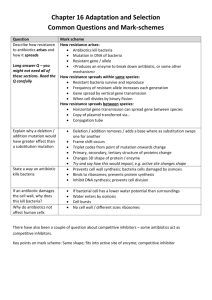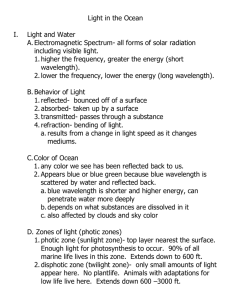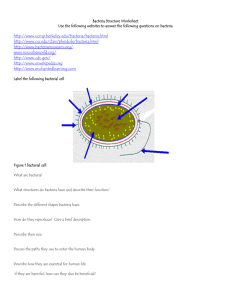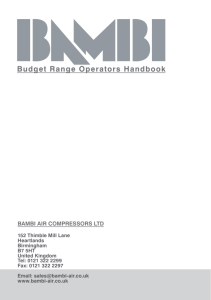Characterization of blue pigmented bacteria isolated
advertisement
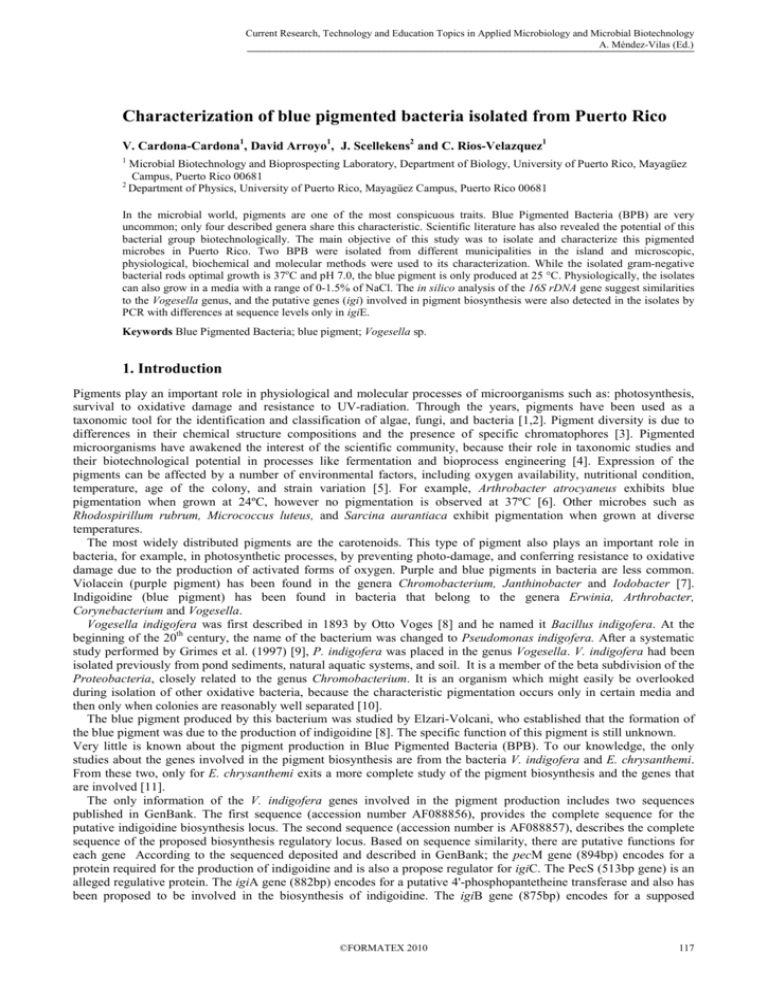
Current Research, Technology and Education Topics in Applied Microbiology and Microbial Biotechnology A. Méndez-Vilas (Ed.) ______________________________________________________________________________ Characterization of blue pigmented bacteria isolated from Puerto Rico V. Cardona-Cardona1, David Arroyo1, J. Scellekens2 and C. Rios-Velazquez1 1 Microbial Biotechnology and Bioprospecting Laboratory, Department of Biology, University of Puerto Rico, Mayagüez Campus, Puerto Rico 00681 2 Department of Physics, University of Puerto Rico, Mayagüez Campus, Puerto Rico 00681 In the microbial world, pigments are one of the most conspicuous traits. Blue Pigmented Bacteria (BPB) are very uncommon; only four described genera share this characteristic. Scientific literature has also revealed the potential of this bacterial group biotechnologically. The main objective of this study was to isolate and characterize this pigmented microbes in Puerto Rico. Two BPB were isolated from different municipalities in the island and microscopic, physiological, biochemical and molecular methods were used to its characterization. While the isolated gram-negative bacterial rods optimal growth is 37oC and pH 7.0, the blue pigment is only produced at 25 °C. Physiologically, the isolates can also grow in a media with a range of 0-1.5% of NaCl. The in silico analysis of the 16S rDNA gene suggest similarities to the Vogesella genus, and the putative genes (igi) involved in pigment biosynthesis were also detected in the isolates by PCR with differences at sequence levels only in igiE. Keywords Blue Pigmented Bacteria; blue pigment; Vogesella sp. 1. Introduction Pigments play an important role in physiological and molecular processes of microorganisms such as: photosynthesis, survival to oxidative damage and resistance to UV-radiation. Through the years, pigments have been used as a taxonomic tool for the identification and classification of algae, fungi, and bacteria [1,2]. Pigment diversity is due to differences in their chemical structure compositions and the presence of specific chromatophores [3]. Pigmented microorganisms have awakened the interest of the scientific community, because their role in taxonomic studies and their biotechnological potential in processes like fermentation and bioprocess engineering [4]. Expression of the pigments can be affected by a number of environmental factors, including oxygen availability, nutritional condition, temperature, age of the colony, and strain variation [5]. For example, Arthrobacter atrocyaneus exhibits blue pigmentation when grown at 24ºC, however no pigmentation is observed at 37ºC [6]. Other microbes such as Rhodospirillum rubrum, Micrococcus luteus, and Sarcina aurantiaca exhibit pigmentation when grown at diverse temperatures. The most widely distributed pigments are the carotenoids. This type of pigment also plays an important role in bacteria, for example, in photosynthetic processes, by preventing photo-damage, and conferring resistance to oxidative damage due to the production of activated forms of oxygen. Purple and blue pigments in bacteria are less common. Violacein (purple pigment) has been found in the genera Chromobacterium, Janthinobacter and Iodobacter [7]. Indigoidine (blue pigment) has been found in bacteria that belong to the genera Erwinia, Arthrobacter, Corynebacterium and Vogesella. Vogesella indigofera was first described in 1893 by Otto Voges [8] and he named it Bacillus indigofera. At the beginning of the 20th century, the name of the bacterium was changed to Pseudomonas indigofera. After a systematic study performed by Grimes et al. (1997) [9], P. indigofera was placed in the genus Vogesella. V. indigofera had been isolated previously from pond sediments, natural aquatic systems, and soil. It is a member of the beta subdivision of the Proteobacteria, closely related to the genus Chromobacterium. It is an organism which might easily be overlooked during isolation of other oxidative bacteria, because the characteristic pigmentation occurs only in certain media and then only when colonies are reasonably well separated [10]. The blue pigment produced by this bacterium was studied by Elzari-Volcani, who established that the formation of the blue pigment was due to the production of indigoidine [8]. The specific function of this pigment is still unknown. Very little is known about the pigment production in Blue Pigmented Bacteria (BPB). To our knowledge, the only studies about the genes involved in the pigment biosynthesis are from the bacteria V. indigofera and E. chrysanthemi. From these two, only for E. chrysanthemi exits a more complete study of the pigment biosynthesis and the genes that are involved [11]. The only information of the V. indigofera genes involved in the pigment production includes two sequences published in GenBank. The first sequence (accession number AF088856), provides the complete sequence for the putative indigoidine biosynthesis locus. The second sequence (accession number is AF088857), describes the complete sequence of the proposed biosynthesis regulatory locus. Based on sequence similarity, there are putative functions for each gene According to the sequenced deposited and described in GenBank; the pecM gene (894bp) encodes for a protein required for the production of indigoidine and is also a propose regulator for igiC. The PecS (513bp gene) is an alleged regulative protein. The igiA gene (882bp) encodes for a putative 4'-phosphopantetheine transferase and also has been proposed to be involved in the biosynthesis of indigoidine. The igiB gene (875bp) encodes for a supposed ©FORMATEX 2010 117 Current Research, Technology and Education Topics in Applied Microbiology and Microbial Biotechnology A. Méndez-Vilas (Ed.) _______________________________________________________________________________________ glutamine dehydrogenase and probably involved in the biosynthesis of indigoidine. The igiC gene (830bp) encodes for a putative N-carboxymaleamide decarboxylase, involve in the biosynthesis of indigoidine. The IgiD (encodes by a 3866bp gene) is a peptide synthetase homologous and is required for the biosynthesis of indigoidine. Finally, the igiE gene (1226bp) encodes an ATPase component of an ABC transporter probably involved in indigoidine export. Studies performed to Puerto Rican soils in a Geomicrobiological research project allowed the isolation of two blue pigmented bacteria (BPB). To our knowledge these are the first BPB isolated and described on the island. Because of the bacteria characteristic pigment, a full characterization of the organism was made. The main focus of this investigation was to characterize biologically, molecularly, and physiologically the BPB’s. Molecular genetics was used in order to identify and amplified the genes that were associated with the production of the blue pigment. 2. Materials and Methods 2.1 Soil analysis A geological study was carried out for the sites where the BPB were isolated, to determine the mineral composition and abundances in the collecting area. 2.1.1 Mineral analysis The soil samples were analyzed to the Geology Department at the UPR-Mayagüez. The samples were analyzed using Siemens D500 X-Ray diffraction instrument. The instrument produces a read out where the refractive ray produces a characteristic peak at a specific angle of refraction (2Θ-) that corresponds to a plane in the crystal structure of the mineral, distinguishing the mineral species. 2.2 Macroscopic and microscopic analysis The isolates were analyzed at macroscopic level by general morphological description of the colony such as the elevation, form, and margin, using the criteria described by Harley and Prescott (2007) (12). The size of the colonies was also measured. The isolates were microscopically analyzed using the Olympus Optical Co., LTD CHT light microscope and Scanning Electron Microscope (SEM). To determine the dimension of the bacteria, 100 of them were selected and measured to calculate the average size. Gram stain was performed using heat-fixed smears. To observe the morphology and dimension of the bacterium, simple stain was performed. Microscopic staining was done to determine the presence of structure such as capsule and endospore (12). For the SEM the bacterium were observed using the JEOL JSM-541 OL SEM microscope. For the analysis, the isolates were grown in Nutrient Broth for 24 hours at 25 ºC in a orbital shaker at 120 RPM. Then, approximately, 1.5 mL of the culture was transferred to a microtube and centrifuged for 1 min at 0.8 g (3,000 RPM) to obtain a cell pellet. Glutaraldehyde at 4% was added to fix the cell pellet and then was left resting for 24 hours at 4ºC. The cell pellet was washed with 1X Phosphate Buffer (PBS) three times. To dehydrate the pellet, different percentage of alcohol were used range from 10% to 100% in 10% intervals. Every ten minutes the pellet was transferred from alcohol to another. To completely dry the sample, a critical point drier (Critical Point Drying Apparatus Polaron E3000) was used. A sputter coater was used to give the samples a palladium-gold cover in order to protect the sample and to add a better conductivity to the specimen. The parameters used above were established by the Scanning Electron Microscopy Center at the University of Puerto Rico, Mayagüez Campus. Electron micrographs were taken at an accelerating voltage of 15 kV. 2.3 Biochemical and physiological test In order to determine the physiology of the isolated BPB, a series of biochemical tests were performed. As controls, Vogesella indigofera (ATCC 19706) and Pseudomonas aeruginosa (ATCC 10145) were used. To determine the range of NaCl that the bacteria can grow, different percentages of salt were used (0%, 0.5%, 1.0%, 1.5% and 2.0%) in Nutrient Broth. Briefly, 5mL of the broth was transferred into tubes where the bacteria were inoculated. The samples were incubated in an orbital shaker at 32°C for 48 hours. To determine the optimal temperature for the pigment production, the isolates were streaked on Nutrient Agar plates. Then, the plates were incubated for four days at different temperatures ranging from 4 ºC to 42 ºC. To determine the optimal pH for the bacteria, tubes with Nutrient Broth at different pH were prepared. The pH range used was from 3.0 to 10.0 at 0.5 units intervals. HCl and NaOH were used to adjust the corresponding pH. Then the medium was inoculated with the isolates bacteria at logarithmic stage. The samples were incubated at 32 ºC for four days. To determine the different enzymes that the bacteria may have, different tests were done. Urea broth was used to see if the bacteria can degrade urea. SIM medium were used to see if the isolates could degrade tryptophan to indole, using the enzyme tryptophanase, and to determine the production of H2S and to see if the bacterium in motile. Starch Agar Media was used to see if the bacterium produced the enzyme amylase. The Nitrate Broth was used to see if the bacterium has the ability to reduce the nitrate to nitrite. The Nutrient Gelatin 118 ©FORMATEX 2010 Current Research, Technology and Education Topics in Applied Microbiology and Microbial Biotechnology A. Méndez-Vilas (Ed.) _______________________________________________________________________________________ Agar was used to see if the isolate produced the exo-enzyme gelatinase. To determine the carbohydrate utilization, assays were performed with sucrose, dextrose, maltose, and mannitol broths with phenol red as indicator. The ability to use glucose, lactose, and sucrose was measured using Triple Sugar Iron Agar (TSIA) slant, the production of H2S and gas were also observed. The utilization of citrate as only carbon source was measured using Simmons Citrate Agar slants. To detect the conversion of pyruvic acid in acetoin, the Methyl Red (MR) test was used and to see the fermentation of glucose and its transformation to pyruvic acid, we used Voges Proskauer (VP) test. All samples were incubated at 32 ºC for 48 hours. Then a post incubation treatment was added to those tests that required it. To the SIM medium, 2-3 drops of the Kovac reagent were added. To the MR medium 7 drops of Methyl Red reagent were added. To the VP medium 10 drops of α–naphthol and 5 drops of KOH 40% were added, and then results were observed after 30 minutes. To the nutrient gelatin medium the post incubation treatment was 30 minutes in the refrigerator. To the starch agar medium 2-3 drops of iodine were added. To the nitrate medium 1 drop of sulfanilic acid and 1 drop of αnaphtilamine were added; if the result was negative, a small portion of zinc powder was added. These tests are described by Harley and Prescott (2007). 2.4 DNA extraction The genomic DNA of the BPB isolated was extracted using the method described by Chen and Kuo (1993) (13). Briefly, the samples were inoculated into Nutrient Broth for 24 hours and 1.5 µl of the sample were centrifuged at 15.7xg (13,000 RPM) to form a cell pellet. The cell lysis was performed using lysis buffer (40mM Tris-acetate pH 7.8, 20mM sodium-acetate pH 8.0, 1.0mM EDTA pH 8.0 and 1% SDS) and sodium chloride 5M, then treated with RNAse (20 µg/µl) for 30 minutes at 37 ºC. An organic extraction was made using one volume of chloroform and then centrifuged at 15.7xg (13,000 RPM); this step was repeated twice. Then the sample was precipitated with absolute ethanol. The isolated genomic DNA was resuspended in 50 µl of distillated sterile water. The final concentration of the DNA was measured using an Eppendorff biophotometer. 2.5 Polymerase Chain Reaction Polymerase Chain Reaction (PCR) was performed with the genomic DNA of the isolate as template in order to amplify part of the 16S rDNA gene. The amplification reaction was made using the Green Taq Master Mix by Promega and Oligo 14-F (5’-AGAGTTTGATCCTGGCTCAG-3’) and 1492-R (5’-GGTTACCTTGTTAGGACTT-3’) as universal bacterial primers (Willmotte and Wachter 1993) (14). The following parameters were used for the reaction: initial denaturalization at 94ºC for 3 minutes; followed by 30 cycles which included denaturalization at 94ºC for 30 seconds, annealing at 52.7ºC for 30 seconds, extension at 72ºC for 1 minute. Then, a final extension at 72ºC was done for 10 minutes. The amplicons were purified using a PCR purification kit (Quagene Inc). The PCR product was sequenced in the facilities Macrogene USA (www.macrogenusa.com). In silico analysis was done by using available online databases such as GenBank in NCBI (http://www.ncbi.nil.nih.gov) by the program BLAST. The complete 16S rDNA sequences were obtained by sending the genomic DNA to the facilities of Macrogene USA. The in-silico analysis was done as mentioned above. 2.6 Phylogenetic Analysis The BPB isolated 16S rDNA sequence were edited using the program Chromas Lite 2.0.0 and then aligned and edited with BioEdit 7.0.0 The phylogenetic analysis was performed using the MEGA 3.1 program. The distance model used was p-distance and the bootstrap test of phylogeny was calculated for 1000 replicates. The creation of the consensus tree was performed by the Neighboor Joining method and the final tree was drawn with the use of MEGA 3 Tree Explorer. 2.7 Primer design to amplify the genes involved in pigment production To amplify the genes proposed to be involved in the indigoidine biosynthesis, the generation of specific primers was necessary. Due to the lack of available primers to amplify igi genes, we used the gene igi sequences described in GeneBank to design the forward and reverse primers. 2.8 Amplification of the indigoidine pigment genes Polymerase Chain Reaction (PCR) was used to amplify each gene with the genomic DNA of the isolate as template. The amplification reaction was made using the Green Taq Master Mix by Promega and primers designed in the Microbial Biotechnology and Bioprospecting laboratory at UPR-Mayaguez. The following parameters were used for the reaction: initial denaturalization at 94 ºC for 3 minutes; 30 cycles of denaturalization at 94 ºC for 30 seconds, annealing at 46.9 ºC for the igiA gene, 45.0 ºC for the igiB gene, 54.9 ºC for the igiC gene and 51.5 ºC for the igiE gene for 30 seconds, extension at 72 ºC for 1 minute and final extension at 72ºC for 10 minutes. The igiD gene measures 3,866 bp. To amplify the gene completely, two reactions were made. For the first reaction the specific primers were igiD1 P1 and ©FORMATEX 2010 119 Current Research, Technology and Education Topics in Applied Microbiology and Microbial Biotechnology A. Méndez-Vilas (Ed.) _______________________________________________________________________________________ igiD1 P2. The following parameters were used for the reaction: initial denaturalization at 94 ºC for 3 minutes; 30 cycles of denaturalization at 94 ºC for 30 seconds, annealing at 47.0 ºC for 30 seconds, extension at 72 ºC for 1 minute and final extension at 72 ºC for 10 minutes. For the second reaction the specific primers were IgiD2 P1 and igiD2 P2. The following parameters were used for the reaction: initial denaturalization at 94 ºC for 3 minutes; 30 cycles of denaturalization at 94 ºC for 30 seconds, annealing at 50.0 ºC for 30 seconds, extension at 72 ºC for 1 minute and final extension at 72 ºC for 10 minutes. The PCR products were purified with a PCR purification kit (Quagene Inc) following the manufacturer especifications. DNA sequencing of the PCR product was done in the facilities Macrogene USA (www.macrogenusa.com). In silico analysis was done by using available online databases such as Gen Bank in NCBI using the program BLAST. 3. Results 3.1 Soil analysis, isolation and characterization of two BPB Two blue pigmented bacteria were characterized in this study. One isolated from the south region of Puerto Rico (BPBW) (accession number HM236169) and the other one from the south-west region of Puerto Rico (BPB-SW) (accession number HM236170). The mineral composition test performed to the soil sample from where the BPB-S was isolated showed strong signals for quartz as a common mineral, follow by vermiculate. In the soils where the BPB-SW was isolated besides quartz, the other weak peaks that represent minerals like anorthite, calcite and vermiculite were detected (data not shown). Macroscopically, and in both blue pigmented isolates, the colonies showed a circular form, convex elevation, entire margin, and metallic deep blue color. Both isolated bacteria were gram-negative. The BPB from the south region forms single rods or pairs of approximately 1.0- 2.5 µm of length by 0.4 µm of width, and the isolated from the south-west region form curved rods that measured approximately 1.0-1.9 µm of length by 0.4 µm of width. Endospores or capsules were not observed. A C E 1mm B D F 1mm Figure 1. Macroscopic and microscopic analysis of the Blue Pigmented Bacteria (BPB) isolated in Puerto Rico. The colonies from the BPB-W (A) and the colonies from the BPB-SW (B) were round, entire, and elevated and the colonies from both measured approximately 2mm. Gram staining of the isolated from the south region (C) and south-west region (D) demonstrates that both bacteria are gram- rods (bars measure 5µm). Scanning Electron Microscopy of the BPB-W (E) and BPB-SW (F), were performed at the UPR-Mayagüez (Biology Department Microscopy Center). Physiologically, the optimal grow parameters was determined. The results indicate that the bacteria grow better at 32 ºC, but without pigmentation. The optimal temperature for the pigment production was 25 ºC. Both bacteria were not able to grow in the absence of oxygen. The bacteria were also able to grow in a pH that range from 5.5 to 8.5. Biochemically, the tests performed to the BPB isolates and compared with the results obtained with V. indigofera (ATCC 19706), showed no differences. 120 ©FORMATEX 2010 Current Research, Technology and Education Topics in Applied Microbiology and Microbial Biotechnology A. Méndez-Vilas (Ed.) _______________________________________________________________________________________ 3.2 Molecular analysis Amplification of the 16S rDNA was done by PCR with positive amplification of approximately 1500bp . Sequencing of the whole 16S rDNA gene was performed by Macrogene USA. In-silico analysis of both BPB suggested that they are 99% similar with each other, but 97% similar with V. indigofera. The phylogenetic analysis demonstrates the two isolates bacteria are very similar to V. indigofera. Gulbenkiania mobilis 16S strain E4FC31T 83 Paludimonas yongneupensis strain 5YN8-15 78 Chromobacterium violaceum ATCC 12472 52 Vogesella indigofera strain ATCC 19706T 99 BPB-W 100 100 BPB-SW Laribacter hongkongensis Burkholderia cepacia 100 Janthinobacterium lividum ATCC 12473 Pseudomonas aeruginosa strain ATCC 10145 Pseudomonas putida strain ATCC 12633 100 100 85 Pseudomonas fluorescens strain ATCC 1352 Pseudomonas syringae A 0.02 Vogesella indigofera strain ATCC 19706T BPB-W 100 BPB-SW B 0.002 Figure 2. Phylogenetic analysis of the BPB. The generation of the consensus tree was made by the Neighbor-Joining method and the final tree was drawn with the use of MEGA 3 Tree Explorer. Numbers in the nodes are the bootstrap values. For the first figure (A) the bar represents 0.02 substitutions per nucleotide position. The second figure (B) is a magnification of the fragment showing the BPB isolates with Vogesella indigofera. The bar represents 0.002 substitutions per nucleotide position. 3.3 Primer design and amplification of the genes involved in the production of the pigment The igiA, igiB, igiC, igiD and igiE genes were successfully amplified in both BPB from Puerto Rico using the primers designed in the laboratory (Fig. 3). ©FORMATEX 2010 121 Current Research, Technology and Education Topics in Applied Microbiology and Microbial Biotechnology A. Méndez-Vilas (Ed.) _______________________________________________________________________________________ A B Figure 3. Amplification of the indigoidine genes of the Blue Pigmented Bacteria (BPB) from Puerto Rico. The putative indigoidine biosynthetic genes (igi) were amplified for both BPB-S (A), and BPB-SW (B). The samples were analyzed by electrophoresis in a 1% agarose gel, using 1Kb as molecular marker. The sample from lane 1-6 represents the amplicons from the genes igiA, igiB, igiC igiD (lane 4 and 5) and igiE, respectively. The in silico analysis of the putative indigoidine biosynthesis genes are shown in Table 1. The identity of the genes when compare to the sequence publish in the GenBank data base range from 87 to 95% in BPB-S and a range from 92 to 95% in BPB-SW of max identity. In both cases the gene with the lowest identity was igiE and the most similar was igiB. Table 1. In-silico analysis of the indigoidine genes from Blue Pigmented Bacteria-South and Blue Pigmented Bacteria-South West. Gene length in V. indigofera Query length Query coverage Max Identity Accession number BPB-W igiA igiB igiC igiD igiE 882bp 875bp 830bp 3866bp 1226bp 816bp 798bp 743bp 2502bp 1150bp 98% 98% 98% 83% 79% 882bp 875bp 830bp 3866bp 1226bp 814bp 797bp 720bp 2375bp 917bp 100% 98% 98% 99% 92% 93% 95% 92% 93% 92% HM488354 HM488355 HM488356 HM488357 HM488358 BPB-SW igiA igiB igiC igiD igiE 93% 95% 92% 94% 87% HM488359 HM488360 HM488361 HM488362 HM488363 BPB-W= Blue pigmented bacterium from the west; BPB-SW= Blue Pigmented bacterium from the south west. For each one of the amplifications the E value was 0. 4. Discussion The main purpose of this research was to identify and characterized blue pigmented bacteria (BPB) isolated from Puerto Rico. BPB are very rare so XRD analysis were carried out to see if some unusual mineral or metals were present. The minerals present in both soils are common in these types of soils, so no unusual minerals were present to explain the occurrence of BPB. The common feature of the soils was that they occur near water bodies, suggesting that this bacterium prefers environments with high water activity (Aw). The data obtained from both BPB were compared with the published data by Grimes (1997) [9], it can be concluded that there is no macroscopic, morphological, or physiologic (based on the tests performed) differences between them. Both bacteria are gram-negative rods. But they are different when compared in size. It appeared that the isolated from 122 ©FORMATEX 2010 Current Research, Technology and Education Topics in Applied Microbiology and Microbial Biotechnology A. Méndez-Vilas (Ed.) _______________________________________________________________________________________ the south range from 1.0- 2.5 µm and the isolated from the south-west range from 1.0 -1.9 µm. So both bacteria differ in size. Physiologically both are aerobic, the optimal growth pH is at 7 and they can not grow in excess of 1.5% of NaCl. With the tests that were performed in this work, no physiological differences were found with the two isolated bacteria and Vogesella indigofera., but further analysis is recommended to determine if there are any physiological differences between them. The optimal temperature for growth for both bacteria was 32 °C, but at this temperature neither of the BPB produced the blue pigmentation. The optimal temperature to produce the pigment was measured at 25 °C. Pigments have been a very important taxonomic tool to identify bacteria species, but identification it’s complicated because there are many physical conditions that can make a bacterium change its pigmentation. Some bacteria may lose the pigments when they are in stress (6). In our case it seems that temperature is the stress point that can make the bacteria change its color. The experiment performed suggests that the bacteria may be sensitive to thermal shock, causing the bacteria to lose the pigment at temperatures higher or lower than 25 °C. This phenomenon can be observed in Serratia marcescens which produce the red pigmentation only when grown at 25°C [15]. Molecularly, all of the genes that have been proposed to be involved in the pigment production (indigoidine) were amplify in both BPB. This suggests that both isolates have genetic potential to produce the blue pigment. All of the genes were very similar between them. This is confirmed phonotypically by the presence of the blue pigment in the colonies growing on solid media. The igi gene that shows to be the most diverse id the igiE gene. Because it has been reported that this gene encodes a component of a ABC transporter probably involved in indigoidine export, the DNA difference could be related to changes that can affect the structure or function of igiE. When the results are compared to the portion of the 16S rDNA gene, both bacteria have a 99% homology to each other and a 97% homology with Vogesella indigofera. Also the molecular analysis of the whole 16S rDNA gene and the phylogenetic tree suggest that the bacteria may be of the Vogesella genus, but they may be different species. The phylogenetic tree place the isolates in the same branch together and near V. indigofera. This suggests that both BPB are very similar and are closely evolutionary related to each other, but not identical to V. indigofera, suggesting two possible new Vogesella-BPB species. In order to confirm this, DNA-DNA hybridization using the Vogesella indigofera type specie needs to be done. Also, the BPB isolates from Puerto Rico have some physiological difference with the Vogesella sp., such as the inability to produce the pigment in liquid medium. This also reinforces the possibility of having a new species or sub-species. Acknowledgements. To the UPR Mayagues Marc and Sloan Programs and PRLSAMP. References [1] Kuhn, R., M. P. Starr, D. A. Kuhn, H. Bauer, and H.-J. Knackmuss. Indigoidine and other bacterial pigments related to 3-3bipyridyl. Archives of Microbiology. 1965;1965;51:71–84. [2] Szczepanowska, H. and C. M. Lovett. A study of the removal and prevention of fungal stains on paper. Journal of the American Institution for Conservation. 1992;31: 147-160. [3] Hui, K. M. and R. E. Hurlbert. Modifiable Chromatophore Proteins in Photosynthetic Bacteria. Journal of Bacteriology. 1979;138: 207-217. [4] Chatoopadhyay, P., S. Chatterjee and S. K. Sen. Biotechnological potential of natural food grade biocolorants. African Journal of Biotechnology. 2008;7: 2972-2985. [5] Starr, M. P. The blue pigment of Corynebacterium insidiosum. Archives of Microbiology. 1958;30: 325-334. [6] Kuhn, D. A. and M. P. Starr. Arthrobacter atrocyneus, n. sp., and its blue pigment. Archives of Microbiology.1960;36: 175-181. [7] Moss, M. O. Bacterial pigments. Microbiologist. 2002;10-12. [8] Kuhn, R., M. P. Starr, D. A. Kuhn, H. Bauer, and H.-J. Knackmuss. Indigoidine and other bacterial pigments related to 3-3bipyridyl. Archives of Microbiology. 1965;51:71–84. [9] Grimes, D. J., C. R. Woose, M.T. MacDowell, and R.T. Colwell. Systematic Study of the Genus Vogesella gen. nov. and its type species, Vegesella indigofera comb. International Journal of Systematic Bacteriology. 1997;47: 19-27. [10] McFadden, B. A. and W. V. Howes. Pseudomonas indigofera. Journal of Bacteriology. 1960;81: 858–862. [11] Reverchon, S., C. Rouanet, D. Expert, and W. Nasser. Characterization of indigoidine biosynthetic genes in Erwinia chrysanthemi and role of this blue pigment in pathogenicity. Journal of Bacteriology. 2002;3: 654-65. [12] Harley J.P., Prescott L.M. Laboratory Exercises in Microbiology. 7th Edition. Mc Graw- Hill; 2007. [13] Chen, W. and T. Kuo. A simple and rapid method for the preparation of gram-negative bacterial genomic DNA. Nucleic Acids Reserve.1993; 21, 2260. [14] Willmotte A. and R. Wachter. Structure of the 16S Ribosomal RNA of the thermophilic cyanobacterium chlorogloeopsis HTF (Mastigocladus laminosus HTF) strain PCC 7518, and phylogenetic analysis. FEBS Letters. 1993;317:96-110. [15] Hejazi A and Falkiner FR. Serratia marcescens. Journal of Medical Microbiology. 1997;46 (11): 903–12. ©FORMATEX 2010 123


